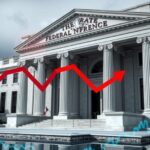Cryptonews
Economy
Politics
BITCOIN, CAPITOL HILL, CRYPTOCURRENCY, CYNTHIA LUMMI, CYNTHIA LUMMIS, FARSIDE INVESTORS, FED, INTEREST RATES, MARKET ANALYSIS, MARKET TRENDS, MATTHEW SIGEL, NEW HAMPSHIRE, NORTHERN MARIANA ISLANDS, OCEANIA, POWELL, TRUMP, US, US STRATEGIC BITCOIN RESERVE, UTAH, VANECK
Omar El-Sharif
Bitcoin Price Forecast: Analyzing US Tariffs, Fed Policy, and ETF Trends
Bitcoin experienced minor gains over the weekend but remains impacted by U.S. economic conditions and Federal Reserve policies, which have led to ETF outflows. Speculation around potential U.S. Strategic Bitcoin Reserves could drive future demand. Both Bitcoin and Ethereum show bearish trends, with movement mechanics largely dependent on upcoming economic policies.
On Saturday, February 15, Bitcoin (BTC) experienced a slight increase of 0.14%, following a 0.93% gain on Friday, concluding the day at $97,706. The lateral movement in BTC’s price, restricted within a $1,000 range indicated investors’ ongoing assessment of supply and demand dynamics. Continued pressure stemming from Federal Reserve policies and challenging U.S. spot ETF inflows prevented Bitcoin from breaching the significant $100,000 threshold.
Recent U.S. economic indicators dampened BTC demand throughout the week ending February 14. Notably, the U.S. Consumer Price Index (CPI) report revealed an uptick in the annual core inflation rate, rising from 3.2% in December to 3.3% in January. During congressional testimony, Federal Reserve Chair Jerome Powell reiterated the bank’s commitment to combatting inflation, which in turn led to a negative response in Bitcoin’s price following the CPI release, driving it down to a low of $94,118.
Despite weaker producer price and retail sales data, the likelihood of a rate cut in June declined from 52.5% on February 7 to 41.3% by February 14, further undermining BTC demand. Influence from the Fed’s anticipated rate path adversely affected ETF flow trends. The U.S. Bitcoin spot ETF market registered $580.2 million in net outflows in the week ending February 14, ending a positive six-week inflow sequence, as reported by Farside Investors.
Notwithstanding these recent outflows, cumulative inflows into BTC-spot ETFs have reached $16.5 billion since former President Donald Trump’s 2024 campaign announcement, substantially increasing from $6.26 billion in the previous corresponding period. Speculation around a potential U.S. Strategic Bitcoin Reserve (SBR) continues to elevate demand for Bitcoin spot ETFs since Trump’s election. In late 2024, Senator Cynthia Lummis introduced the Bitcoin Act, proposing the acquisition of one million BTC over five years, secured for a 20-year holding period.
In various states, including Utah and New Hampshire, legislation has been enacted to explore state-level SBRs, spurring interest from additional states. Matthew Sigel of VanEck underscored the potential impact of such initiatives, indicating that if 20 analyzed state-level Bitcoin reserve bills were enacted, they could trigger buying of around $23 billion, translating to approximately 247,000 BTC.
The anticipated legislation overseeing SBRs at the state level could render a national SBR more likely, potentially propelling BTC to unprecedented valuation levels. Attorney John E. Deaton commented, “If the US Government approves Senator Lummis’ Bill and commences Bitcoin purchases, it would likely prompt similar actions from other nations, potentially creating a scenario of national-level fear of missing out (FOMO).” He suggested that such developments could lead Bitcoin to reach $1 million faster than anticipated.
The future trajectory for BTC largely hinges upon developments regarding U.S. tariffs, the Federal Reserve’s policies, advancements related to SBRs, and overall ETF flows. Notably, despite recent uplifts, BTC struggles to surpass the 50-day and 200-day Exponential Moving Averages (EMA), signaling bearish trends. A breakout above the 50-day EMA could activate heightened upward momentum toward the crucial $100,000 mark, while a decline below $95,000 might target the support level at $90,742.
With the 14-day Relative Strength Index (RSI) currently positioned at 47.25, there is a risk of BTC falling beneath the $90,742 support threshold before reaching oversold conditions. In parallel, Ethereum (ETH), the second-largest cryptocurrency by market capitalization, also remains below its 50-day and 200-day EMAs, indicating bearish indicators. A breakthrough at ETH’s resistance level of $2,815 could lead to increased movement toward the $3,287 resistance range, while a dip below $2,500 might extend losses to the $2,308 support level.
ETH’s RSI reading at 39.25 suggests a possibility of a downward trajectory below the $2,500 threshold before approaching oversold territory. The pathway for Bitcoin to achieve $110,000 appears ambiguous as traders remain vigilant regarding shifts in the Fed’s rate policies, U.S. tariffs, and Bitcoin ETF dynamics. Ongoing macroeconomic conditions and U.S. cryptocurrency regulations will play a critical role in steering market sentiments moving forward.
In summary, Bitcoin’s recent price movements have been influenced by U.S. economic indicators, Federal Reserve policies, and Bitcoin-spot ETF flows, keeping BTC below the crucial $100,000 mark. The potential introduction of state and national Strategic Bitcoin Reserves may alter demand significantly. Regardless, Bitcoin’s future trajectory remains uncertain amidst these shifting dynamics. With Ethereum similarly facing bearish indicators, both cryptocurrencies’ movements will be influenced by upcoming macroeconomic developments and regulatory policies.
Original Source: www.fxempire.com







Post Comment